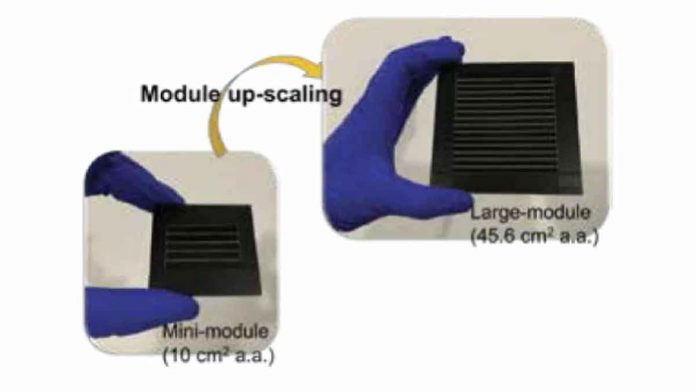Scientists have achieved a groundbreaking milestone in renewable energy technology with their demonstration of an industrial-scale technique for producing perovskite photovoltaic materials.
The development promises to be a game-changer, as it not only reduces costs but also significantly enhances the performance of mass-produced perovskite solar cells.
Unlocking the Potential of Perovskite
Perovskite has long been recognized as a material of great interest for solar cells, boasting exceptional light-absorption properties that rival traditional silicon cells.
Its potential lies in the creation of lightweight and flexible solar cells, which can be seamlessly integrated into various applications, including windows for buildings and vehicles.
However, until now, the challenges of scaling up production using conventional methods like spin coating have hindered its practical adoption.
A Low-Cost and Energy-Efficient Breakthrough
Researchers have successfully overcome these obstacles with a new, innovative technique that is both low-cost and energy-efficient.
Unlike previous approaches, this cutting-edge method paves the way for large-scale manufacturing of perovskite solar cells, bringing us one step closer to a renewable energy revolution.
Spin Coating Reimagined
The conventional spin coating method involves applying a liquid material onto a substrate and then spinning the substrate, allowing the liquid to spread evenly.
While this technique had been used to apply perovskite, its compatibility with the unique properties of the material posed a significant challenge.
One critical issue was the evaporation of solvents used to keep perovskite in a liquid state.
This rapid evaporation resulted in much of the perovskite flying off the edges, leading to wastage and inconsistent thickness across the surface.
These irregularities not only impacted the overall efficiency of the solar cell but also created manufacturing complexities.
Reducing Waste, Increasing Efficiency
The breakthrough technique addresses these challenges head-on, significantly reducing wastage and toxic by-products associated with perovskite photovoltaics.
As a result, production becomes more environmentally friendly while achieving remarkable uniformity and performance.
Embracing the Future of Solar Technology
Collaborators on the project are now utilizing this technique to create modules of substantial size, reaching tens of centimeters.
The resulting products exhibit outstanding uniformity and efficiency, cementing perovskite’s position as a frontrunner in the quest for sustainable and renewable energy solutions.
A Brighter Tomorrow
With perovskite photovoltaics moving one step closer to full-scale commercialization, the energy landscape is set to undergo a transformation.
Affordable and high-performance solar cells hold the promise of powering our homes, businesses, and vehicles, while simultaneously reducing our carbon footprint.
The researchers’ groundbreaking achievement underscores the significance of continued investment in clean energy research.
As we forge ahead into a greener future, the potential of perovskite and other emerging technologies should not be underestimated.
Together, we can harness the power of the sun to build a sustainable and eco-conscious world for generations to come.
In conclusion, the progress made in producing perovskite photovoltaic materials on an industrial scale signifies a monumental leap towards a cleaner, more sustainable energy future.
This scientific breakthrough not only lowers production costs but also unlocks the true potential of perovskite solar cells, offering a flexible and efficient alternative to conventional silicon cells.
As the world embraces renewable energy solutions, the brilliance of perovskite shines ever brighter, illuminating the path to a greener and more prosperous tomorrow.

